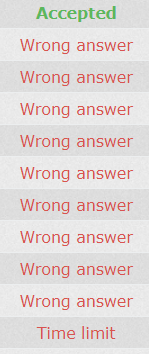Background
Stacks and Queues are often considered the bread and butter of data structures and find use in architecture, parsing, operating systems, and discrete event simulation. Stacks are also important in the theory of formal languages.
This problem involves both butter and sustenance in the form of pancakes rather than bread in addition to a finicky server who flips pancakes according to a unique, but complete set of rules.
The Problem
Given a stack of pancakes, you are to write a program that indicates how the stack can be sorted so that the largest pancake is on the bottom and the smallest pancake is on the top. The size of a pancake is given by the pancake's diameter. All pancakes in a stack have different diameters.
Sorting a stack is done by a sequence of pancake ``flips''. A flip consists of inserting a spatula between two pancakes in a stack and flipping (reversing) the pancakes on the spatula (reversing the sub-stack). A flip is specified by giving the position of the pancake on the bottom of the sub-stack to be flipped (relative to the whole stack). The pancake on the bottom of the whole stack has position 1 and the pancake on the top of a stack of n pancakes has position n.
A stack is specified by giving the diameter of each pancake in the stack in the order in which the pancakes appear.
For example, consider the three stacks of pancakes below (in which pancake 8 is the top-most pancake of the left stack):
8 7 2
4 6 5
6 4 8
7 8 4
5 5 6
2 2 7
The stack on the left can be transformed to the stack in the middle via flip(3). The middle stack can be transformed into the right stack via the command flip(1).
The Input
The input consists of a sequence of stacks of pancakes. Each stack will consist of between 1 and 30 pancakes and each pancake will have an integer diameter between 1 and 100. The input is terminated by end-of-file. Each stack is given as a single line of input with the top pancake on a stack appearing first on a line, the bottom pancake appearing last, and all pancakes separated by a space.
The Output
For each stack of pancakes, the output should echo the original stack on one line, followed by some sequence of flips that results in the stack of pancakes being sorted so that the largest diameter pancake is on the bottom and the smallest on top. For each stack the sequence of flips should be terminated by a 0 (indicating no more flips necessary). Once a stack is sorted, no more flips should be made.
Sample Input
1 2 3 4 5
5 4 3 2 1
5 1 2 3 4
Sample Output
1 2 3 4 5
0
5 4 3 2 1
1 0
5 1 2 3 4
1 2 0
题意:一摞盘子,从上到下。个数1=<N<=30,盘子直径D,1~100,求:每次只能执行从顶部到某一个的反转,也就是像堆栈一样,先倒出来,再倒回去,最终实现,从顶到底有序(升序)。输出每次反转的位置(即每次反转的底层位置),编号从底到顶从1~N。
解析:根据自己的模拟,需要每次找一个最大值,以它为反转开始点反转到第一个位置,再从它所对应的正确位置反转到正确位置。所以需要另开一个数组p[]排好序来记录原数组的排序后的状态,第一层for倒序p[]来更换最大值,第二层for来找出等于当前最大值而且不重合的数,进行swap操作。这里面有个细节就是对于j!=1时,需要先把它搞到最前面,然后再是放到最后面。最后注意输入输出,输入时小心T掉。
2个h,WA了9次,T了1次,相当不容易地搞出来了。也许我是个菜鸡吧,但是我提高了,我就很满意啦。

#include<iostream> #include<cstdio> #include<cstring> #include<algorithm> using namespace std; const int maxn=105; int a[maxn],p[maxn]; void ac(int id) { for(int i=id;i>=id/2+1;i--) swap(a[id-i+1],a[i]); } int main() { while(scanf("%d",&a[1])!=EOF) { if(getchar()=='\n') { cout<<a[1]<<endl<<"0"<<endl; continue; } int tot=1; p[1]=a[1]; while(1) { tot++; scanf("%d",&a[tot]); p[tot]=a[tot]; if(getchar()=='\n') break; } for(int i=1;i<tot;i++) cout<<a[i]<<" "; cout<<a[tot]<<endl; sort(p+1,p+1+tot); for(int i=tot;i>=0;i--) { if(a[i]==p[i]) continue; for(int j=i-1;j>=1;j--) { if(a[j]==p[i]) { //cout<<a[j]<<"--"<<i<<endl; if(j!=1) { cout<<tot-j+1<<" "; ac(j); } cout<<tot-i+1<<" "; ac(i); break; } } } cout<<"0"<<endl; } }